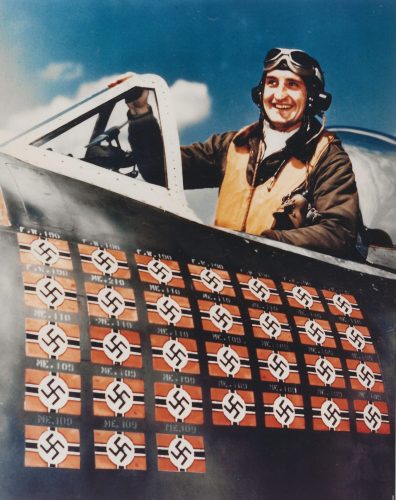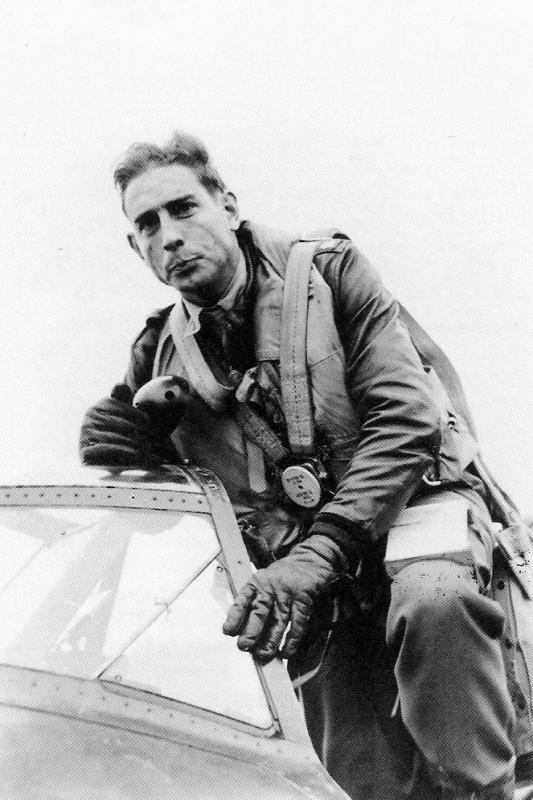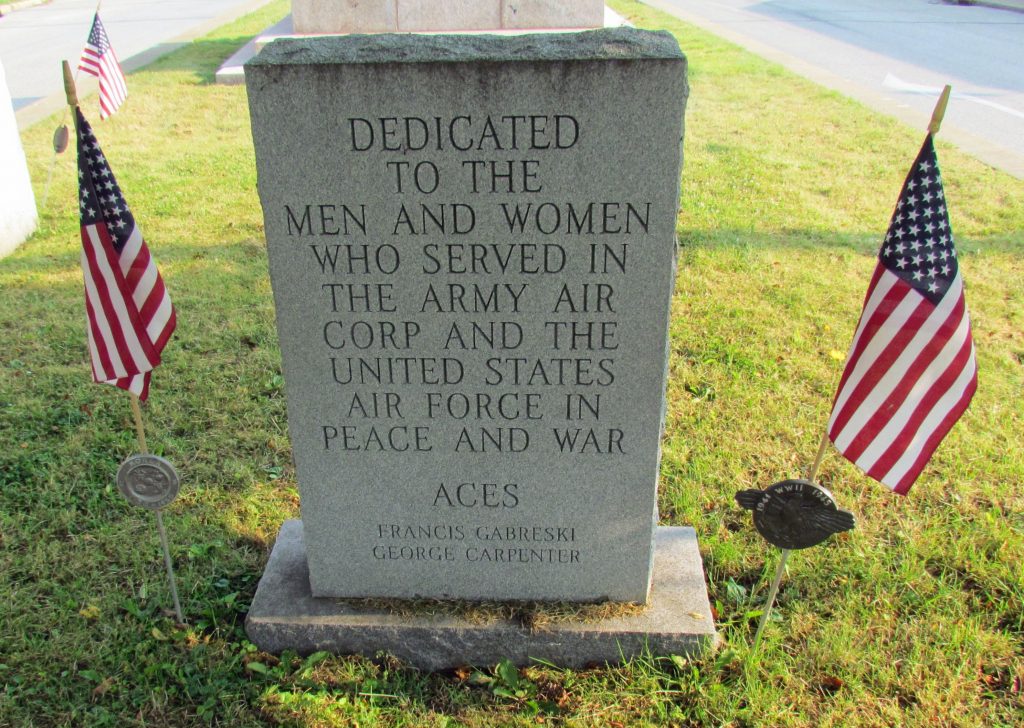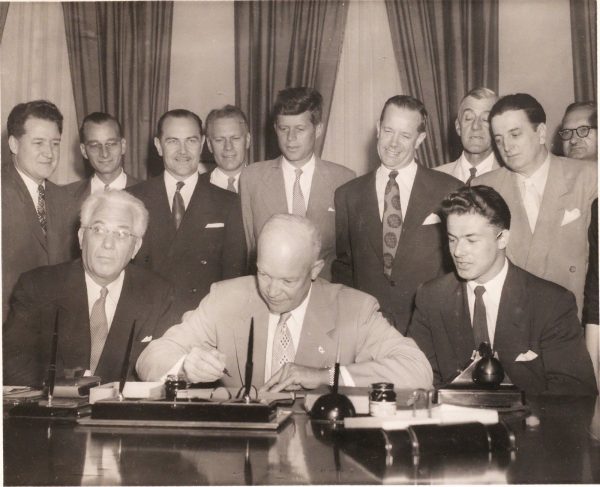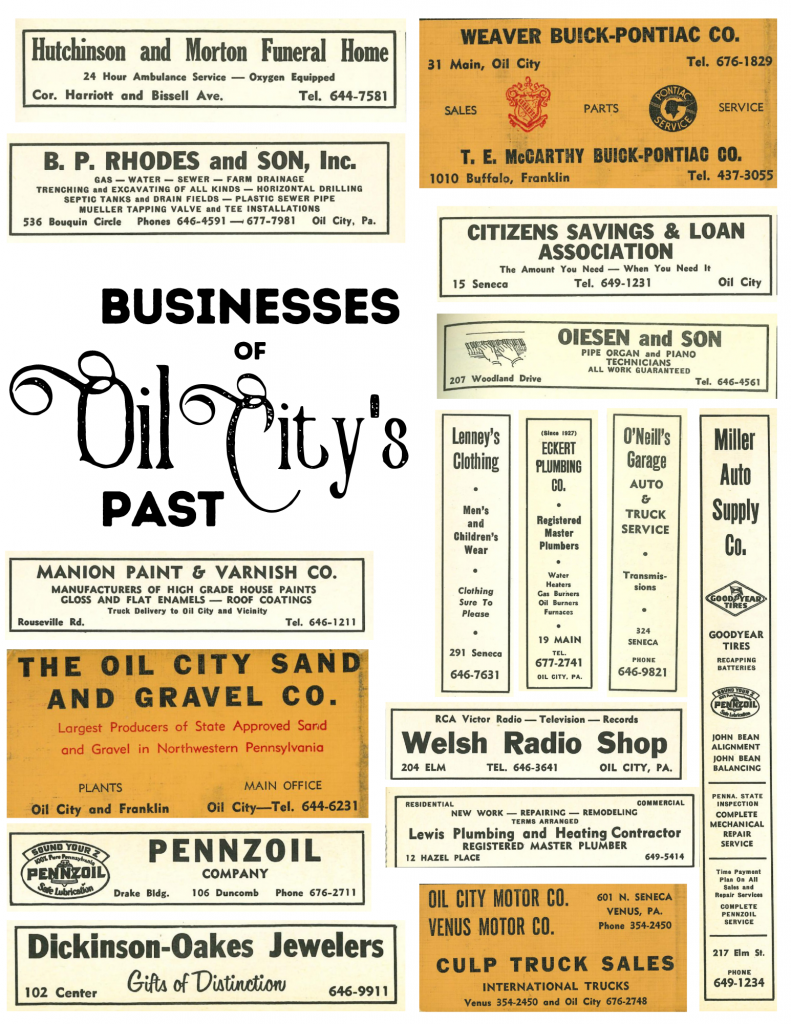Oil City Aces
- Judy Etzel
- November 5, 2021
- Hidden Heritage
- 3794
Oil City has a long and enduring history of sending its young men and women into harm’s way as soldiers, sailors and Marines. The city has been well represented in all U.S. conflicts. Our veterans have been highly honored for their service and valor.
Among the most famous veterans from the city were two residents who ranked as top aerial aces – Francis Gabreski and George Carpenter. Both were Oil City High School graduates and Army Air Corps fighter pilots in World War II. Prior to joining the U.S. service, Carpenter served in a British squadron and Gabreski flew in a Polish unit.
Each man was captured while on a bombing mission and each flyer was taken prisoner by the Germans and interned at a prison camp in 1944.
In visits back home many years later, each flyer emphasized that he was not a hero and that the term should more appropriately be applied to those who did not safely return home. It was a duty and a privilege to serve the nation, said Carpenter and Gabreski.
Francis “Gabby” Gabreski
He was the son of Polish immigrants to Oil City and worked part time in his parent’s Purity Market store on Main Street. The Stanley and Josephine Gabryszewski family lived on Spruce Street.
He briefly attended Notre Dame University after graduating from Oil City High School in 1938 but left the university in 1940 to join the U.S. Army Air Corps.
Within a year, Gabreski was temporarily assigned to Europe to serve as a fighter pilot with the Polish Air Force. The posting was due mainly to his fluency in the Polish language. He flew 20 missions with the unit until he joined the U.S. 61st Fighter Squadron out of England.
His first aerial victory was in August 1943 when he downed a German Messerschmitt over France. After 75 missions as pilot of British Spitfires and American P-47 Thunderbolts, Gabreski was named an air ace. He became America’s leading ace in July 1944 with a record of 28.5 planes destroyed (the one-half unit was due to sharing the aerial kill with a wingmate).
Eligible for a furlough to return for a rest in the U.S., Gabreski agreed to make one more run. On July 20, 1944, he led his squadron over a German airfield near Coblenz. While strafing the terrain, Gabreski had to crash land. He escaped the burning wreckage and eluded capture for five days until apprehended by the Germans. He was held in a POW camp until liberated 11 months later by the Russian Army.
He would continue his military career in the U.S. Air Force in the Korean War and again earned ace status by downing .5 jet fighters. Gabreski was only one of seven American combat pilots who won ace status in both World War II and Korea. His cumulative record made him the top living air ace in the U.S. He retired in October 1967 and joined the Grumman Corp. and later the Long Island Railroad. The pilot died in 2002.
George Carpenter
The Townville native graduated from Oil City High School in 1935 and enrolled at Grove City College. He was the son of George and Augusta Carpenter who lived on Mayer Street.
Carpenter left college before he could graduate and joined the Royal Air Force in Great Britain as part of the American Eagle Squadron. He was known to his fellow pilots as “Old Ironsides.” In September 1942, Carpenter was transferred to the U.S. Army Air Corps.
In the spring of 1944, the pilot was in charge of a London-based Mustang fighter squadron that flew as part of a force of more than 2,000 Flying Fortresses, Liberators and fighter planes bound to destroy Nazi airplane bases near Berlin.
Carpenter’s plane was shot down and he parachuted into enemy territory where he was immediately taken prisoner. His parents were notified he was missing in action, a status that would not change until it was confirmed months later that he had been imprisoned at a POW camp. He was held there for nearly two years.
Carpenter was named an ace within a time period of just months. In less than three months in 1944, Carpenter shot down 14 enemy planes and destroyed several more on the ground.
The pilot returned to Oil City with his British war bride after the war. He briefly worked in the lumber business but soon returned to Grove City College where he graduated in 1952. He later earned a medical degree and had a family medical practice in Paris, Tennessee. He died in 2005.
Aces are Honored
Gabreski and Carpenter were jointly honored by their hometown in 2000 when they were named honorary grand marshals for the annual Oil Heritage Festival parade.
In addition, a granite monument in the Central Avenue Plaza pays tribute to their military service. It was dedicated in 1997 by the American Legion, Veterans of Foreign Wars and the Disabled American Veterans posts in the city.
In 2001, Route 8 between Oil City and Franklin was named the Francis S. Gabreski Highway.
Frank Jarecki
A Venango County resident drew international headlines in 1953 when he fled his native Poland while flying a new MIG-15 Russian jet enroute to sanctuary in the U.S.
Frank E. Jarecki, a resident of Poland, was a top-rated pilot who was chosen, at the age of 20, to test fly the Soviet Union’s top secret MG jet. While patrolling the Polish-Germany border area, he left his unit and headed north.
In a talk several years later before the Oil City Kiwanis club, Jarecki said he was “pursued by four Polish jets from his home base and eight other Russian jets.” He tossed aside extra fuel tanks and sped up the jet to a speed of 700 miles per hour. There were constant radio calls for him to return to his base but Jarecki responded that he was on “a secret mission to get medicine” for an ill Joseph Stalin, Soviet dictator. Ironically, his excuse for leaving his unit coincided with the death that same day of Stalin.
Seeking Allied air bases on a cluster of Danish islands, Jarecki ended up landing the jet in a pasture on the island of Bornholm. He was met by Dutch troops as he walked towards the coast, taken to Copenhagen and, once authorities were sure he was not a Russian spy, was given safe passage to Great Britain which granted his political asylum.
He quickly immigrated to the U.S. where he was granted citizenship by an act of Congress. One of his chief advocates was then Sen. John F. Kennedy.
Jarecki was the guest of honor at a reception hosted by President Dwight Eisenhower at the White House. He was offered a movie contract by Howard Hughes, who suggested Marlon Brandon could play the lead role.
The U.S. Air Force signed him up as a consultant.
Meanwhile, the MIG jet was closely examined by U.S. and other European officials who, until that time, had only viewed photographs of a MIG jet because of its secrecy and location behind the Iron Curtain.
Jarecki was offered a sizable amount of money for putting the jet into U.S. hands but refused it, saying he was “only interested in being a free man.”
Jarecki enrolled at Alliance College, a Cambridge Springs institution operated by a coalition of Polish organizations. He was awarded an honorary degree in 1980.
The former pilot took on a job as a salesman for the Oil City Machine and Tool Co. in Reno and later was named research engineer for the company. A few years later, Jarecki launched his own company, Jarecki Industries, on 13th Street in Franklin. It expanded to Erie County a few years later. The family moved from Reno to Erie where he bought the Commodore Downs race track.
Jarecki, who received several patents during his business career, entered politics and became Slovak coordinator for Gerald Ford’s presidential campaign.
In 2003, the flight suit he wore when he defected to the West was acquired by the Smithsonian Institution in Washington, D.C. Jarecki died at the age of 79 in 2010.
William E. Copley
The Oil City Minor League baseball field in the Hasson Heights neighborhood is known as the Copley Field.
It is dedicated to an Oil City man who was highly decorated for his U.S. Army service in World War II and the Korean War.
William E. Copley, an outstanding athlete at Oil City High School, was one of eight brothers serving in the U.S. Army during World War II.
He served with the 83rd Tank Destroyer Battalion that saw action in Normandy and in Germany. Copley was awarded two Silver Stars and a Bronze Star, all for gallantry in action.
Returning to the U.S., he and his wife and their three children moved to Bradford, Pa. He was recalled to active Army duty in 1951 and deployed to Korea. First Lt. Copley was killed in action in 1952 in Korea.
Renowned Photographer
Julien Hequembourg Bryan of Titusville, described in post-World War II articles as “the oft forgotten eyewitness to history,” took hundreds of photographs in Europe on the eve of Germany’s invasion of Poland in 1939.
His pictures, which included people and scenes from across Europe, were smuggled out in a gas mask container to the U.S. Many of the film shipments originated in Nazi Germany. They were published in newspapers and magazines across the U.S. It was a collection that included the siege of Warsaw, battle scenes, Nazi gatherings and more.
He was, according to a 2010 story in the Smithsonian magazine, the only “neutral country reporter working in Warsaw, Poland, during the Nazi invasion” that began World War II.
He later published a book and created a documentary, each called “Siege”, and the film was nominated for an Academy Award. His pictures and films related to the war are preserved in the U.S. Holocaust Memorial in Washington, D.C.
Titusville researcher David Weber said Bryan, the son of Mr. and Mrs. Samuel Bryan of Main Street, was born in 1899 in Titusville and graduated in 1916 from Titusville High School. His father was a partner with oilman Joseph Seep in the Bryan Hardware store there and he also owned oil and gas properties throughout the region.
Bryan went to work as a railroad stake driver and then joined the American Field Service as a volunteer ambulance driver in Europe during World War I. Returning home, he enrolled at Princeton where he earned a degree.
The photographer was asked to film the life and culture of Latin American nations by the U.S. Office of War Information with an eye towards using it as propaganda.
In 1965, Bryan won an Academy Award for the best short documentary. He was also instrumental in developing the Imax system and was the founder of the International Film Festival.
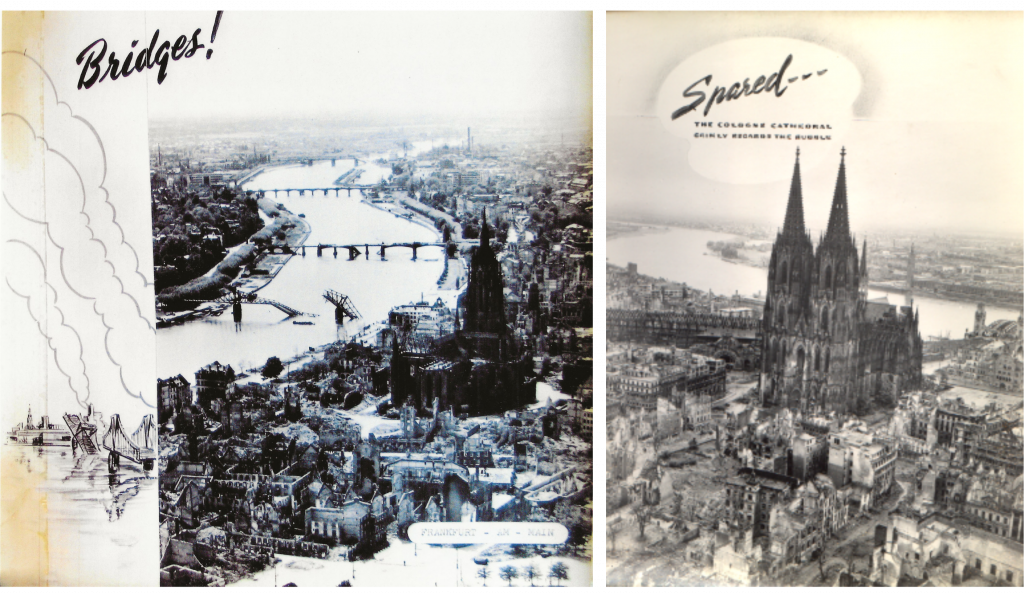
Support This Project
Donations to the library are appreciated to help offset printing costs & make this project possible!
Make a DonationWritten by Judy Etzel with research by Kay Dawson and design by Natalie Cubbon.

